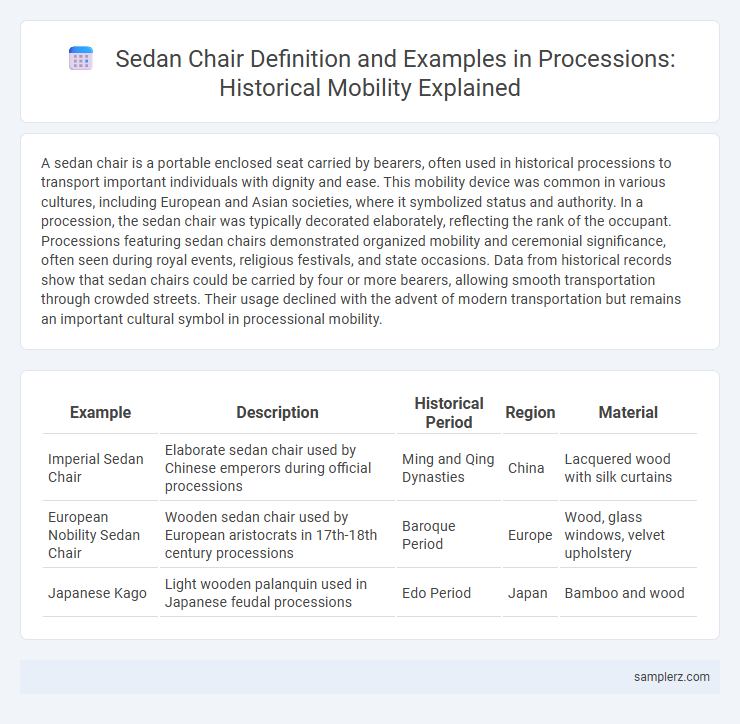A sedan chair is a portable enclosed seat carried by bearers, often used in historical processions to transport important individuals with dignity and ease. This mobility device was common in various cultures, including European and Asian societies, where it symbolized status and authority. In a procession, the sedan chair was typically decorated elaborately, reflecting the rank of the occupant. Processions featuring sedan chairs demonstrated organized mobility and ceremonial significance, often seen during royal events, religious festivals, and state occasions. Data from historical records show that sedan chairs could be carried by four or more bearers, allowing smooth transportation through crowded streets. Their usage declined with the advent of modern transportation but remains an important cultural symbol in processional mobility.
Table of Comparison
| Example | Description | Historical Period | Region | Material |
|---|---|---|---|---|
| Imperial Sedan Chair | Elaborate sedan chair used by Chinese emperors during official processions | Ming and Qing Dynasties | China | Lacquered wood with silk curtains |
| European Nobility Sedan Chair | Wooden sedan chair used by European aristocrats in 17th-18th century processions | Baroque Period | Europe | Wood, glass windows, velvet upholstery |
| Japanese Kago | Light wooden palanquin used in Japanese feudal processions | Edo Period | Japan | Bamboo and wood |
Historical Overview of Sedan Chairs in Processions
Sedan chairs were essential mobility devices in historical processions, serving as portable thrones for nobility and dignitaries across Asia and Europe from the 16th to 19th centuries. These enclosed passenger chairs, often ornately decorated, were carried on poles by attendants, symbolizing status and power during ceremonial events. Their use highlights the evolution of personal transportation before mechanized vehicles transformed procession mobility.
Cultural Significance of Sedan Chair Processions
Sedan chair processions historically symbolized social status and political power across various cultures, particularly in imperial China and feudal Japan. These processions served as ceremonial displays during significant events such as royal weddings, religious festivals, and official state functions, reinforcing hierarchical structures and communal identity. The intricate designs and elaborate decorations of the sedan chairs further emphasized cultural artistry and craftsmanship, making them iconic representations of mobility and prestige.
Iconic Examples of Sedan Chair Use in Royal Ceremonies
Iconic examples of sedan chair use in royal ceremonies include the British monarchy's state processions, where elaborately decorated chairs carried dignitaries in traditional coronations and investitures, symbolizing royal authority and prestige. In Asian cultures, such as Imperial China and Japan, sedan chairs were integral to royal parades, transporting emperors and high-ranking officials while showcasing intricate craftsmanship and vibrant designs. The consistent use of sedan chairs in these royal ceremonies highlights their role in mobility as a status symbol and ceremonial artifact throughout history.
Religious Festivals Featuring Sedan Chair Processions
Religious festivals often feature sedan chair processions as a symbol of reverence, where deities or sacred relics are carried through streets to invoke blessings and community participation. This traditional mobility method highlights cultural heritage in events such as the Chinese Lantern Festival and India's Rath Yatra, showcasing intricate craftsmanship and ceremonial significance. The use of sedan chairs enhances the spiritual atmosphere by blending mobility with ritualistic procession, reinforcing collective faith and social cohesion.
Sedan Chairs in Traditional Wedding Parades
Sedan chairs in traditional wedding parades symbolize cultural heritage and social status, often ornately decorated with vibrant fabrics and intricate designs to enhance the procession's visual appeal. These mobile structures are carried by attendants, providing a regal and intimate means of transporting the bride or groom through crowds during ceremonial journeys. Their prominence in Asian and historical European weddings highlights their role in emphasizing honor and celebration within cultural mobility traditions.
Artistic Depictions of Sedan Chairs in Processions
Artistic depictions of sedan chairs in processions frequently showcase elaborate designs adorned with intricate carvings and vibrant colors, emphasizing their importance in ceremonial mobility. Paintings and sculptures from various cultures highlight the sedan chair as a symbol of status and power, often surrounded by attendants and ornate decorations. These visual representations capture the dynamic interplay between mobility and social hierarchy inherent in traditional procession practices.
Regional Variations in Sedan Chair Processions
Sedan chair processions display distinct regional variations, with Southeast Asian versions often featuring intricate lacquered designs and vibrant fabrics, while European styles emphasize ornate carvings and gilded embellishments. In Chinese processions, brightly painted sedan chairs symbolize status and are carried by multiple bearers, contrasting with the more modest, utilitarian Sedan chairs in Indian ceremonies that focus on functional mobility. These differences highlight how cultural values and climatic conditions influence the construction, decoration, and ceremonial usage of sedan chairs across regions.
Symbolism of Sedan Chairs in Festive Parades
Sedan chairs in festive parades symbolize prestige and cultural heritage, often representing authority and social status. Their elaborate decorations and vibrant colors highlight communal pride and tradition during public celebrations. These mobile thrones serve as iconic symbols of honor and festivity in ceremonial processions.
Modern Re-enactments of Sedan Chair Processions
Modern re-enactments of sedan chair processions preserve historical mobility traditions by showcasing ornately decorated chairs carried by multiple bearers in ceremonial parades. These events emphasize cultural heritage and craftsmanship, often coordinated with festivals or heritage days to educate the public. The re-enactments provide immersive experiences that highlight the social and symbolic significance of sedan chair transport in transporting dignitaries or royalty.
Preservation of Sedan Chair Procession Traditions
The preservation of sedan chair procession traditions remains vital in showcasing cultural heritage and historical mobility practices. Communities actively restore ornate sedan chairs and train participants in traditional carrying techniques to maintain authenticity and ceremonial significance. These efforts ensure the continuity of historic procession rituals, highlighting the intricate social and mobility customs of past eras.

example of sedan chair in procession Infographic
 samplerz.com
samplerz.com